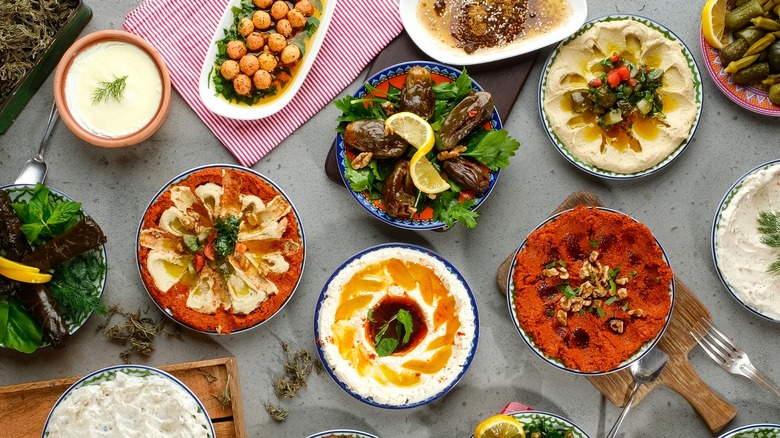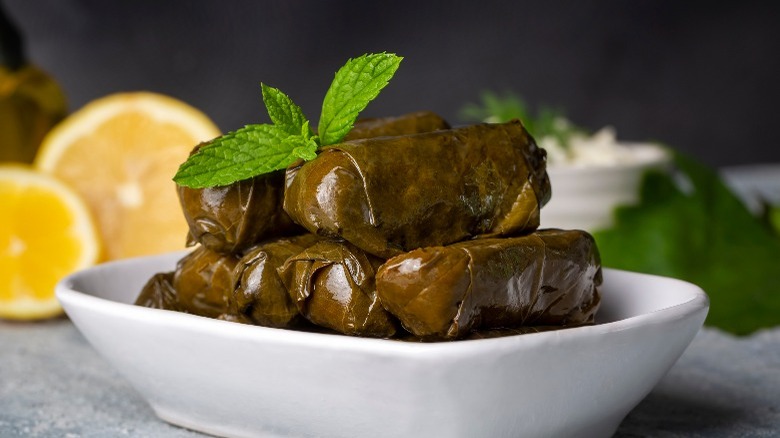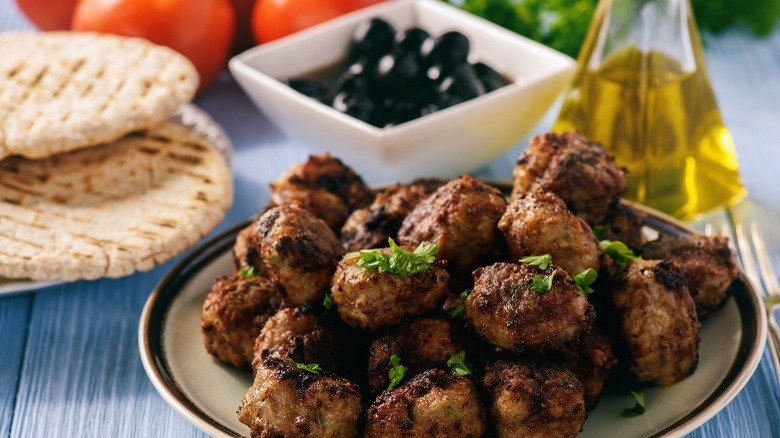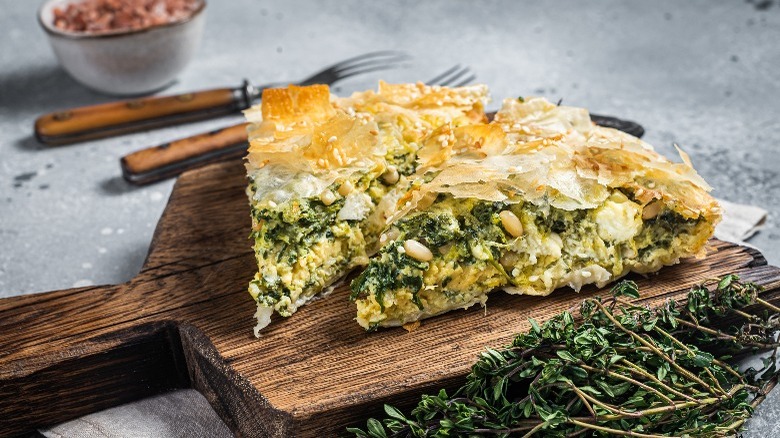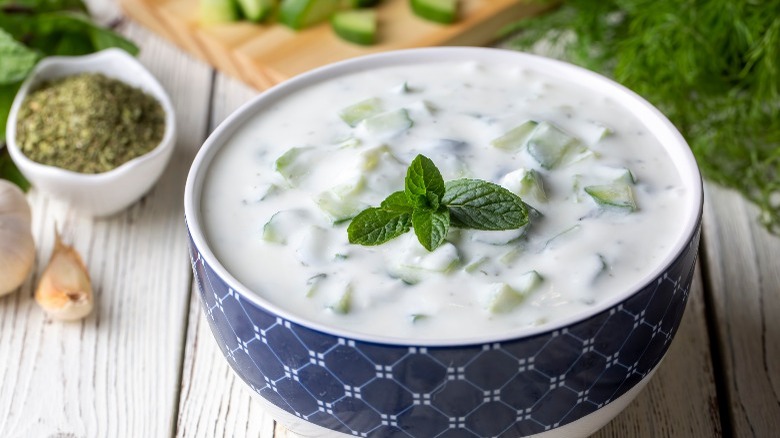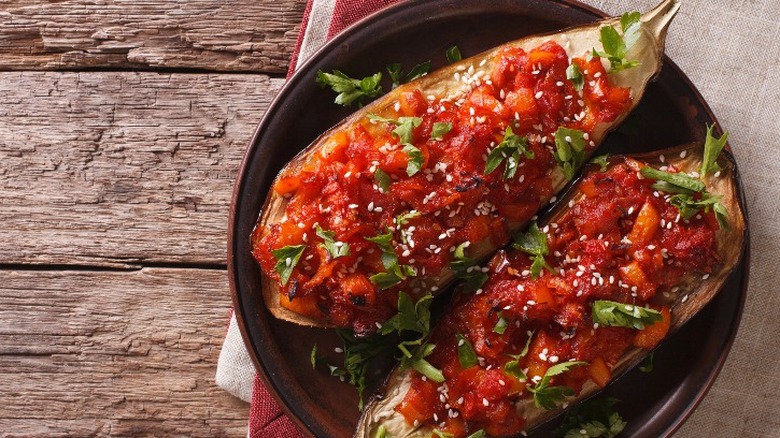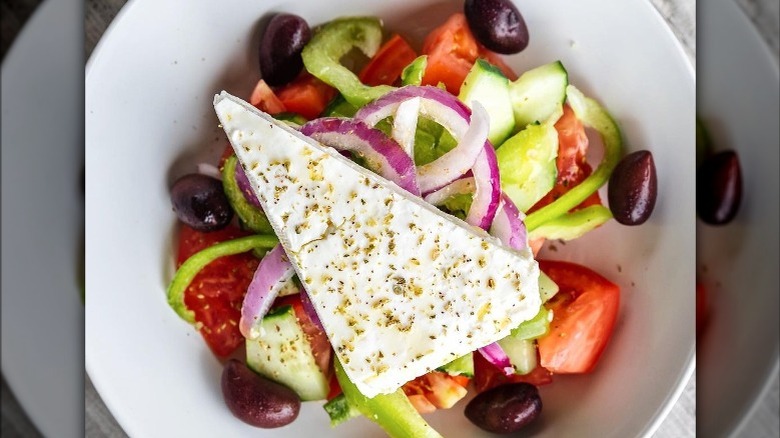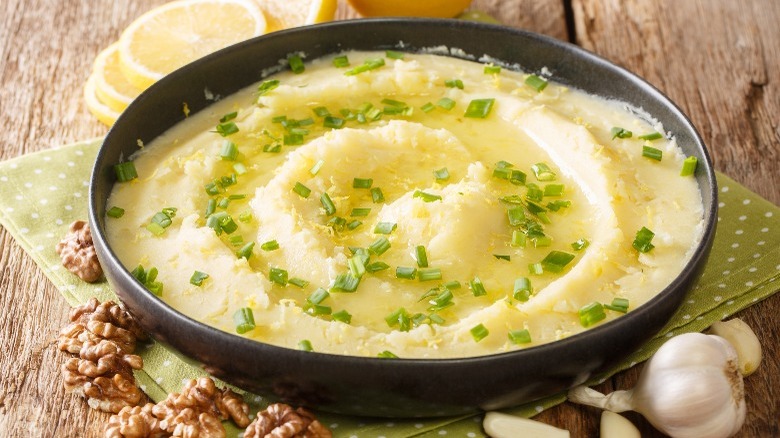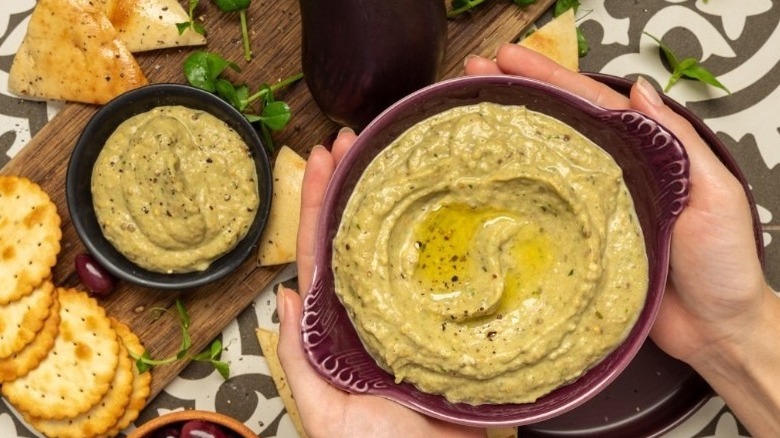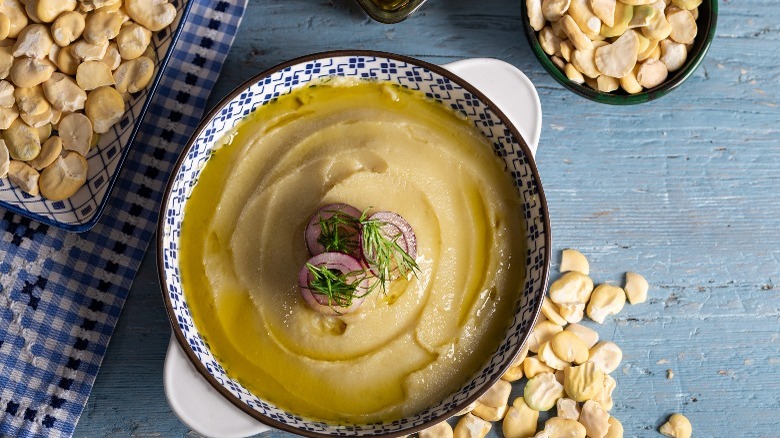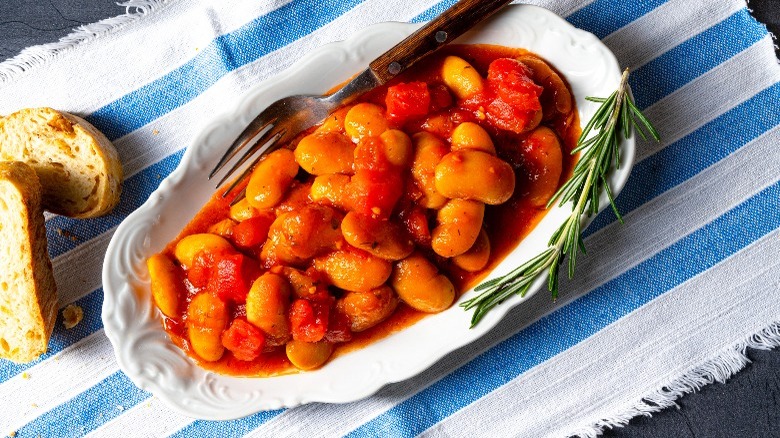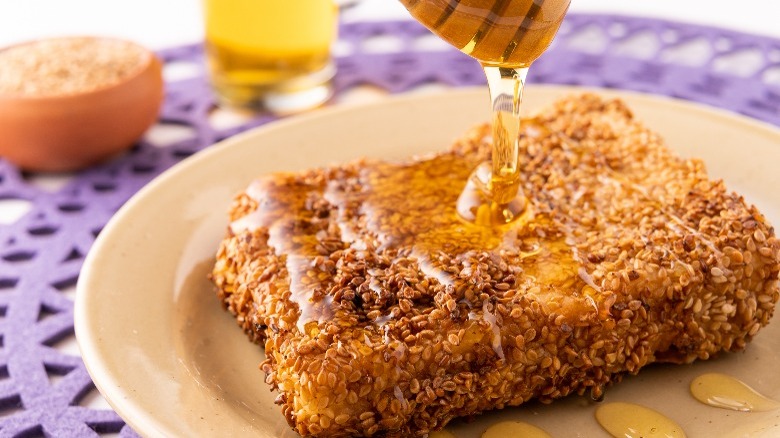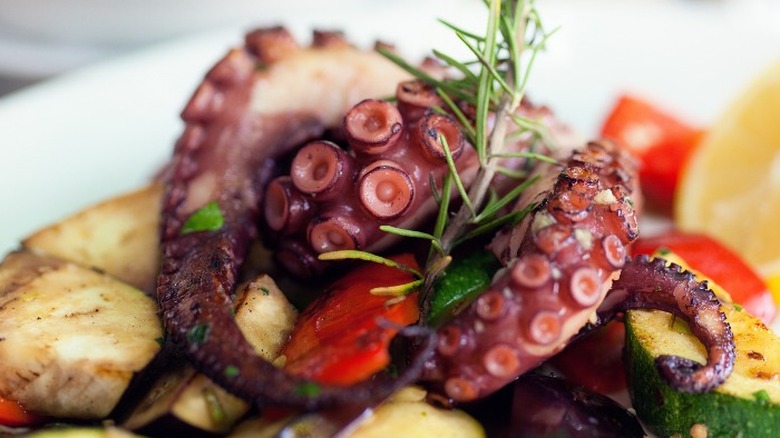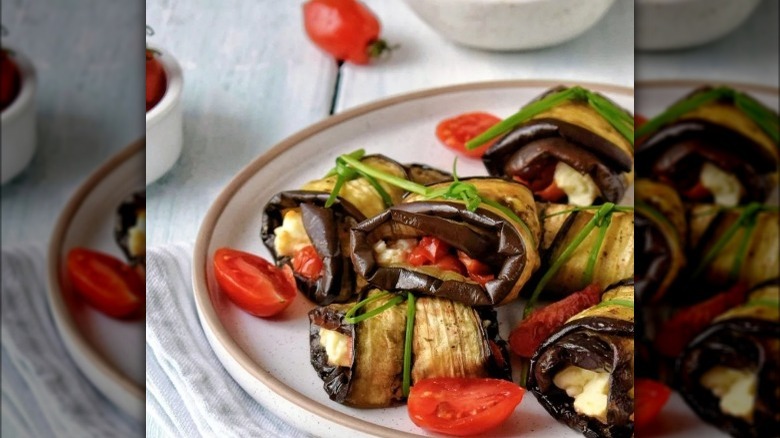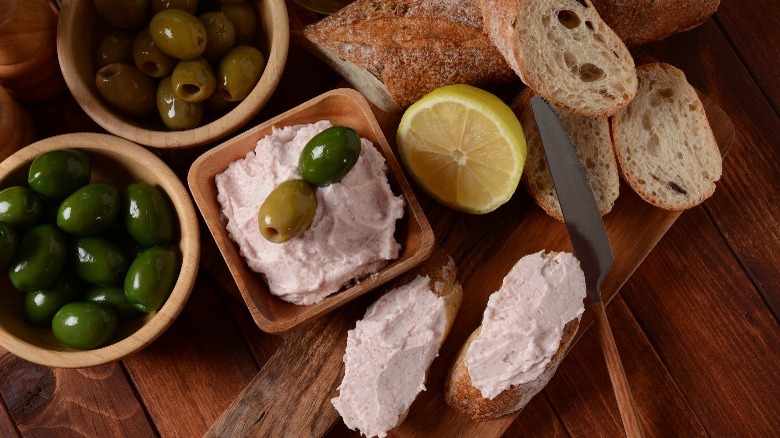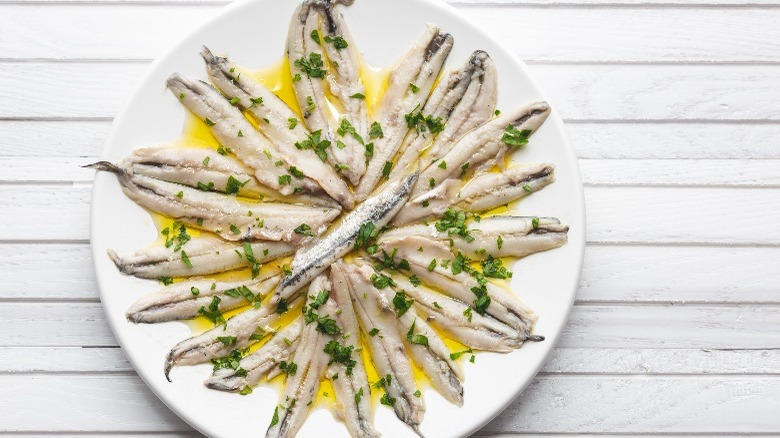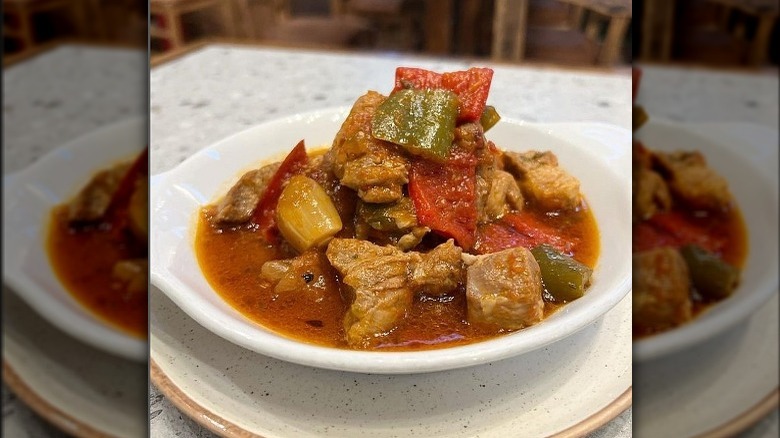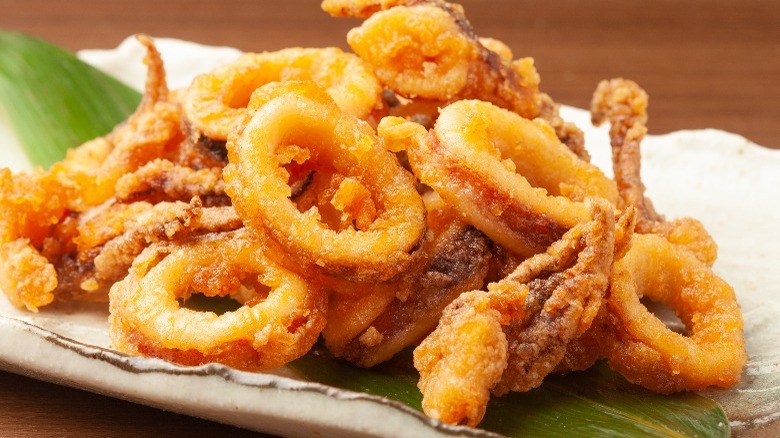The 18 Best Greek Mezze Dishes You Need To Order
On any trip to Greece — or visit to a Greek restaurant in your hometown — one of the highlights is surely Greek mezze, a selection of delicious small plates to share with family and friends. The word mezze is actually thought to have originated from Turkish culture, with the word mazzeh meaning appetizer.
Traditionally, a mezze includes a selection of hot and cold dishes, with dips, bread, meat, and vegetable dishes, plus drinks. Popular across Middle Eastern countries, it became a popular way to bring together many favorite dishes while socializing.
The culture of mezze is connected heavily with the Greek word parea, meaning a group of friends who gather together purely to enjoy each other's company and celebrate the simple things in life by eating, drinking, and having fun. From the delicate flavors of spanakopita to hearty bekri meze, drunken pork stew, and dolmades, we'll introduce you to some of the best Greek mezze dishes to order next time you're dining out — or to try making at home.
1. Dolmades
Dolmades are an essential addition to any mezze spread. Originating in ancient Greece, the word dolma was actually borrowed from the Turks. This dish can be served warm or cold and consists of vine leaves stuffed with minced meat, rice, seasoning, herbs, and sometimes pine nuts. In the past, fig or borage leaves were sometimes also used.
Some recipes for dolmades leave out the meat, while others include plump, juicy raisins. If you're making your own dolmades, you'll find frozen vine leaves or vine leaves in brine sold in many stores or available online. Frozen leaves will require defrosting and soaking to soften, while brine-soaked leaves need a good double rinse to remove the saltiness before use.
In Greece, you'll often find dolmades served as a snack as well as part of a mezze platter. They're usually served with a sauce, which can be avgolemono, an egg and lemon sauce, or a rich tomato sauce.
2. Keftedes
When you hear Greek people talk about keftedes, they most commonly mean Greek meatballs made with a mix of ground pork and beef, lamb, or even veal. However, keftedes can also be used to refer to zucchini fritters, a popular light and crispy mezze dish that often includes fresh dill or mint.
It's thought that the word keftedes may come from the Persian word kofta, meaning to beat or to grind. This makes a lot of sense, as keftedes are made with ground meat, most commonly lamb.
Garlic, oregano, mint, cumin, and coriander are added to the meat, with an egg and breadcrumbs to bind the mixture into meatballs. Most recipes also include Greek kefalotyri cheese, but you can easily sub parmesan or pecorino — or a similar hard cheese — instead.
These Greek meatballs can be grilled or fried and are traditionally served with fresh, warm toasted pita bread and plenty of creamy tzatziki. You'll also find them on many Greek restaurant menus as a main, served alongside a horiatiki salad.
3. Spanakopita
Spanakopita is a delicious addition to any mezze spread, but it's also commonly served in Greece as a snack or light lunch. Don't be fooled by its simple ingredients, as this Greek spinach and cheese pie is absolutely delicious. It has a rich history, too — it's thought to date back over 400 years and may have its roots in the mountainous region of Epirus in northwest Greece.
Salty, tangy feta cheese is mixed with fresh spinach, eggs, nutmeg, and garlic, layered between sheets of rich, buttery, flaky phyllo pastry. In some spanakopita recipes, Greek yogurt is added for a moist filling. Served hot or cold, spanakopita is absolutely delicious.
You'll find this Greek delicacy served as a larger pie, cut into individual portions, or as smaller, triangular-shaped pastries. Spanakopita is one of the most popular Greek snacks you'll find worldwide. If you live in a major U.S. city, chances are there's a Greek deli or bakery near you serving up homemade spanakopita.
4. Tzatziki
Tzatziki is a classic Greek dip that's become popular worldwide, and you'll find it in many Greek delis as well as larger stores. With tangy, creamy Greek yogurt, fresh, cool cucumber, red wine vinegar, extra virgin olive oil, salt, and plenty of garlic, it's a simple recipe that's easy to make yourself at home, and it goes with absolutely everything.
If you're enjoying tzatziki as part of a mezze spread, you'll normally find it served with crudités and warm pita bread for dipping or as a side with keftedes, Greek meatballs. Some recipes add sour cream, and it's easy to use dairy-free yogurt for a vegan-friendly version.
When in Greece, you'll often hear tzatziki referred to as gyros sauce as it's the sauce most commonly served with souvlaki, grilled meat in pita bread. In Cyprus, you'll find Talatouri, a very similar dip that substitutes lemon juice for vinegar and adds mint.
5. Imam Bayildi
This eggplant dish is actually Turkish, but you'll commonly find it served as part of a mezze spread wherever you are in Greece. The name Imam bayildi literally means the Imam fainted in Turkish. As the story goes, the first Imam to try the dish loved it so much that he fainted.
This vegetarian dish makes the most of fresh eggplants, stuffing them with a tomato filling made with garlic, caramelized onions, smoked paprika, cumin, oregano, and fresh mint or parsley. As well as being an excellent addition to a mezze, it's often served as a main dish in Greek and Turkish restaurants, alongside salad, steamed vegetables, or rice.
Imam Bayildi can be baked in an oven or cooked on the stovetop. If you want to make the dish heartier and more filling, try adding a can of chickpeas or white beans to the tomato filling. Some recipes even include a hint of Middle Eastern spice with the addition of sumac.
6. Horiatiki (Greek Salad)
Who doesn't love a refreshing, cool Greek salad? Unlike many other salads that have leafy greens as their base, horiatiki, a Greek Salad, uses a base of cucumber and plump, juicy tomatoes, with black olives, crumbled feta cheese, onions, and an oregano and olive oil dressing. Fresh herbs such as parsley or mint are often added, too.
As well as being an essential part of your mezze, horiatiki salad is an excellent accompaniment to grilled meats and keftedes. It can also be served as a delicious light lunch with some tzatziki and warm pita bread.
Depending on which part of Greece you're visiting, another salad you may see served as part of mezze is fattoush salad. This Lebanese dish is basically a fried bread salad. It's a great way to use up stale bread, which is fried and added to lettuce, tomatoes, cucumber, green pepper, green onions, and radishes.
7. Skordalia
Though making a dip from potatoes and garlic might not sound like the most tempting idea ever, don't shun skordalia until you've tried it. This simple Greek dip is so flavorful that you'll definitely be unable to resist.
In Greek, skordo means garlic, and there's enough garlic in this dip to keep even the most ardent garlic lovers happy. With potatoes, garlic, olive oil, red wine vinegar, and salt, you could easily make your own skordalia at home, but somehow it won't taste quite like the version you'll enjoy at a Greek restaurant or from your local deli.
Some traditional versions of skordalia use stale bread as a base rather than potatoes. Nuts can also be used. The bread version is slightly lighter than the potato-based dip.
If you are making your own skordalia and you don't want to reek of garlic, you can boil peeled garlic in milk for 5 minutes before adding it to the dip. This gives the finished dish a milder flavor and is great for serving kids.
8. Melitzanosalata
As you've probably noticed by now, eggplants feature in many Greek mezze dishes, and they're at their best during the hot summer season. Melitzanosalata is a Greek eggplant dip that's not to be confused with baba ganoush, which is more of an eggplant hummus thanks to the addition of tahini.
With its light, smoky flavor, it's easy to see why melitzanosalata is one of the first dips to vanish from the mezze table. Red onion, plenty of garlic, olive oil, lemon juice, and fresh parsley are added to the roasted eggplant. Either lemon juice or red wine vinegar is added for sharpness. Some recipes call for the addition of crumbled feta for a creamy finish and salty flavor, but you could also add crumbled goat's cheese.
However it's made, melitzanosalata is best served with an array of brightly colored veggies for dipping and plenty of fresh, warm pita bread. Its smoky flavor is also the perfect complement to grilled meats or keftedes.
9. Fava
No Greek mezze is complete without an array of dips, and fava is a popular choice. Don't be fooled by this dip's name, though, as it doesn't actually contain any fava beans. The word fava refers to the yellow split peas that give this dip its vibrant color and creamy texture. Fans of lentil soup will enjoy this rich dip that's often topped with roasted tomatoes and caramelized onions.
The very best fava uses split peas cultivated on the Greek island of Santorini, where they have been grown for 3,500 years. Thanks to the island's volcanic soil, the split peas grown here have a sweeter flavor and creamier texture than those harvested elsewhere.
For added flavor, yellow split peas can be simmered in vegetable stock before blending them with red onion, garlic, olive oil, lemon juice, and spices. Oregano, ground cumin, and sea salt are usually added, but you can also use a bay leaf, thyme, or rosemary.
10. Gigantes Plaki
Gigantes plaki may sound like an elaborate Greek dish, but it actually just means giant baked beans. The most common beans used are fasolia gigantes, often referred to as elephant beans, which have a creamy flavor and keep their shape when cooked in the sauce. If you're making this dish at home, you could substitute dried lima beans or butter beans.
The beans are baked in a rich tomato sauce with onions, carrots, and leeks, studded with plenty of fresh herbs. As part of a mezze, that sauce is ripe for mopping up with pita bread.
Gigantes plaki is usually served warm but are also delicious at room temperature and can be prepared in advance. As well as being an excellent addition to a selection of mezze dishes, you'll often find these beans served as a side dish with grilled meats or even as a vegetarian main dish.
11. Feta Saganaki
Saganaki actually refers to a range of Greek mezze dishes prepared in a saganaki pan, which has a heavy base and two handles. One of the most popular saganaki dishes is made with feta cheese.
Dipped in a simple egg and flour coating, the salty block of feta cheese is then pan-fried until crispy. Some recipes add a coating of sesame seeds to the outside. Some recipes add dried herbs or spices to the flour, such as a dash of paprika or some oregano.
Feta saganaki is delicious when served with a drizzle of Greek honey or a squeeze of fresh lemon. As well as feta saganaki, you'll find shrimp saganaki and mussels saganaki on offer in many restaurants, too.
In the United States, you'll sometimes find Greek restaurants serving flaming saganaki, where the cheese is flipped in some ouzo or brandy that's set on fire. This isn't a traditional Greek dish, though, and was actually invented in a restaurant in Greektown, Chicago, in the 1960s.
12. Htapodi
Htapodi means octopus in Greek, and you'll find this delicacy served in a variety of different ways as a mezze, appetizer, or main course. One of the most common ways to serve octopus as part of mezze is htapodi xidato, where the octopus is boiled and then marinated in oil and wine vinegar. It can also be grilled and sprinkled with lemon juice.
You may also find enjoy htapodokeftedes, octopus fritters, which are deliciously light and crispy and usually come with a side of tzatziki. Htapodi salata, or octopus and potato salad with green onions, parsley, olive oil, lemon juice, and capers, is another dish that's definitely worth adding to your mezze.
Xtapodi, or Greek-style octopus, is a heartier dish where the octopus is boiled in red wine vinegar before being added to onions, tomatoes, and garlic. Balsamic vinegar, honey, and fresh parsley are then incorporated into the rich sauce. If you're by the sea in Greece, any type of htapodi is excellent as part of a mezze, as you're assured the freshest octopus.
13. Bourekakia
Eggplant rolls are not unique to Greek cuisine — you'll find similar Italian recipes — but nevertheless, bourekakia are a delicious addition to any mezze or served as an appetizer or side dish. The traditional recipe for bourekakia uses the Greek fresh cheese anthotyro, which is soft and hard cheese kefalograviera.
If you're preparing this dish at home, you can substitute ricotta and parmesan or other similar cheeses. You can also adapt bourekakia for vegan diners by using vegan feta and vegan parmesan.
Eggplant slices are fried in olive oil before being rolled up and stuffed with cheese, sundried tomatoes, and basil. The rolls are served in a spicy sauce made with fresh tomatoes, garlic, basil, and green chili. While this dish sounds quite similar to Imam Bayildi, the use of sundried tomatoes and green chili gives this a spicy kick and real depth of flavor that makes bourekakia distinctively different.
14. Taramasalata
Taramasalata is one of the more common Greek dips found in delis and stores across the globe. However, the version you see outside of Greece is often pink due to the addition of food coloring.
Authentic Greek taramasalata is a light yellow color, similar in appearance to hummus, though depending on the type of roe used, it can be a very pale pink, too. Made with salted, cured fish roe, usually carp, cod, or gray mullet, it's delightfully smooth, creamy, and salty.
This dip is as simple as it gets: Fish roe is blended with stale white bread, lemon juice, olive oil, and red onion. The process for making taramasalata involves emulsifying the mixture — blending it while slowly adding the oil — much like making mayonnaise. Since fish roe can vary in terms of its salt content, you can always soak your roe in water for 10 minutes or so to reduce the saltiness before adding it to the other ingredients.
In restaurants, taramasalata is served as part of a mezze or as an appetizer alongside other dips, with plenty of fresh, warm pita bread for dipping. You'll often find it sprinkled with fresh parsley or paprika for color.
15. Gavros
Gavros is the Greek word for anchovies, and these little fish are extremely popular in Greece. During a mezze, you'll often find gavros marinatos, where the fish are cured and marinated in salt, red wine vinegar, and olive oil.
Anchovies can also be served roasted or fried, where they are known as gavros tiganitos. Commonly, a plate of them is served as a small dish during a mezze or as an appetizer, but they're also sometimes served on slices of crusty bread, similar to bruschetta.
Another popular Greek dish you'll often find served is gavros ladorigani, baked anchovies with oregano. The anchovies are marinated in a mixture of olive oil, lemon juice, garlic, and oregano, then baked in a hot oven.
However you enjoy your anchovies during your mezze, don't forget to have a glass or two of wine to hand. These flavorful little fish also go well with ouzo, Greece's national drink, as the anise flavors perfectly complement the salty fish.
16. Pastourmadopitakia
Pastirma is an acquired taste. This air-dried cured beef packs a garlic and spice crust, tsimeni, that's rich in fenugreek.
Once upon a time, horsemen cured their own pastirma and carried it with them on long journeys away from home. Its strong aroma and flavor aren't for everyone, so those who don't enjoy a plate of thinly sliced cured meat often use it to make pastourmadopitakia.
This pie is made with pastirma, kasseri cheese — an unpasteurized sheep's milk cheese — and tomato encased in crunchy yet delicate phyllo pastry. You'll either find smaller individual triangle pies or a larger rectangular pie that is cut into pieces. Some recipes use puff pastry, sfoliata, instead.
You can make your own pastirma at home, though the salting, curing, and aging process takes around a month. Most Greek delis and specialty supermarkets will stock this air-dried beef, making pastourmadopitakia a speedy recipe to put together at home.
17. Bekri Meze
Bekri meze is not only an essential part of any Greek mezze, but it's also a delicious main dish in its own right. Bekri means drunk, and this drunken pork stew includes chunks of pork cooked in a hearty red wine sauce packed with colorful peppers, cumin, smoked paprika, and kefalotyri cheese.
If you're making this at home, you can easily sub gruyère cheese or kasseri if you can get hold of it. Many recipes add a sprinkle of red pepper flakes for spiciness. Whether served as part of a mezze or a main course, plenty of pita or a side of fries is a must for mopping up the rich, flavorful sauce.
You'll find bekri meze served at almost every taverna across Greece, but it's a simple yet impressive recipe that anybody can make at home. Enjoy your stew with a glass of Greek red wine to complement the spicy tomato sauce.
18. Kalamarakia
Almost everyone has heard of crunchy, fried calamari, or squid, known in Greece as kalamarakia. During the hot Greek summers, this is one of the most popular mezze dishes, often served alongside htapodi. You'll also find it served as a snack or appetizer.
Greek kalamarakia, also called kalamarakia tiganita, is light, crispy, and served piping hot with a squeeze of fresh lemon. There's nothing quite like it, especially when enjoyed alongside a cold beer.
Preparing this mezze dish at home? Frozen squid will give you a crunchier outer finish with a juicy, tender inside, but you can also use fresh squid. If you're enjoying kalamarakia on your trip to Greece, look for a psarotaverna, or fish tavern, by the sea, as it's here you'll find the freshest catch of the day.
Calamari is also a healthier choice than some other dishes as it's high in protein and low in calories, though deep frying it definitely adds calories. It's also packed with omega-3 fatty acids, selenium, and vitamins B12 and B6.
